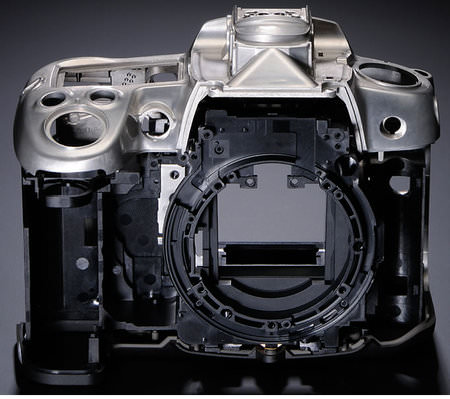

Instead, autofocus during live view and movie capture is always performed using contrast detection autofocus, which operates based on data streaming from the image sensor - the same technique referred to as Tripod mode on some models. Unlike some of Nikon's digital SLRs, the D7000's Live View mode - from which Movie recording is initiated - lacks the company's separate Handheld and Tripod modes. The more sophisticated encoding used in the H.264 standard requires quite a bit of processor power to pull it apart and put it back together again, so frame-accurate editing of H.264 requires a fast processor and capable editing program. (AVCHD uses a subset of the H.264 standard, which among other things mandates a limit in recording bandwidth, translating into a lesser ability to convey rapidly-changing detail.) The choice of H.264 comes with the requirement of greater processing power, though - not only from the camera when recording, but also when playing back or editing videos.

It also avoids some of the severe image quality loss suffered by AVCHD cameras, when faced with significant amounts of change in image content between frames. Compared to the Motion JPEG format used by some cameras, H.264 is much more conservative of memory card space. The Nikon D7000 records movies using H.264/MPEG-4 AVC compression with Linear PCM audio, and stores them in. Nikon hasn't explained the reason for the time limit as of this writing, but it's likely due to sensor heating issues that might start to degrade image quality. Regardless of resolution and frame rate, recording times are limited to 20 minutes or four gigabytes per clip, whichever limit is reached first. With this standard definition mode, recording frame rates are fixed at either the nominal 30 fps for NTSC, or 25fps for PAL. Finally, the non-standard 640 x 424 pixel mode has an approximate 3:2 aspect ratio. If switched to PAL format, the D7000 alternatively offers a 25 fps rate. When the D7000's video output is set to the North American NTSC format, the secondary movie recording rate is nominally 30 fps, and actually 29.97 fps.
#Nikon d7000 full#
This offers a choice of two frame rates - either the same nominal 24 frames per second as in Full HD mode, or a secondary rate that varies depending upon the Video mode setting in the Setup menu. The intermediate 1,280 x 720 pixel resolution also has a 16:9 aspect ratio, and is better known as 720p. Movies at this resolution are nominally recorded at a rate of 24 frames per second, although the precise capture rate is actually 23.976 fps. The highest resolution 1,920 x 1,080 pixel mode is commonly known as Full HD or 1,080p, and has a 16:9 aspect ratio. The Nikon D7000 records movies at three progressive scan resolutions: either 1,920 x 1,080, 1,280 x 720, or 640 x 424 pixels.
#Nikon d7000 manual#
Options include resolution, quality, frame rate (720p movies only), microphone sensitivity / muting, recording destination, and whether the D7000 should allow manual exposure control. Nikon D7000 Video: Image Size, Frame Rate, and Encoding More experienced videographers will find intriguing possibilities in the D7000's ability to control movie exposure manually, to accept an external microphone, and to adjust audio gain. Also key for many consumers will be the availability of contrast detection autofocusing with tracking capability during video recording, albeit with some adverse effects on video and audio quality. Key among the changes is the availability of Full HD (1,080p) video capture, recorded using H.264/MPEG-4 AVC compression. Although there are some important differences, the D7000's video mode retains much of the DNA from Nikon's prosumer D300S model, including some features that are rare even among more expensive cameras, let alone at this price point. A little over two years later, high definition video recording has become a de rigueur feature available on a wide selection of SLRs at every price point, right the way down to the entry level.

In 2008, Nikon kicked off a new era for SLR cameras with the introduction of the D90, the world's first DSLR with video recording capability. (Regular photos taken with the Nikon D7000) (Thumbnails of all shots, including RAWs, with EXIF data) (Index to all standard test shots, with explanations)

(Crops from images shot with the camera's kit lens, if sold as a kit) Check out the links below for more sample images, videos and image quality analysis:


 0 kommentar(er)
0 kommentar(er)
